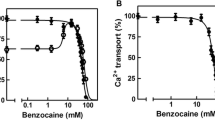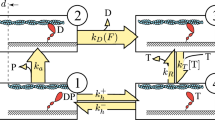Summary
The influence of the composition of the preincubation medium on the histochemical demonstration of myofibrillar actomyosin ATPase, including a variety of carboxylic acid and non-carboxylic acid buffering compounds and neutral salts, was studied. In inorganic salt-free systems the rate of the activation of type I fibers and inactivation of type II fibers was accelerated when the carboxylic acids had longer chain length or multiple carobxyl groups. Of these factors, the number of carboxyl groups was dominant with a 100 mM citrate buffer producing a sharp differentiation between fiber types. In contrast, the time course of the response was exceptionally long in an acetate buffer. The time course of the ATPase reaction was also modified by other buffers at pH 4.60. The most notable were an ascorbate — glycine buffer system which produced little or no deviation from the alkaline preincubation staining pattern after prolonged preincubation and a pyrophosphate system which produced a rapid change. Neutral salts in the preincubation medium accelerated the time course of the inactivation — activation process with the order for the halogen salts of K+ being F−<Cl−<Br−<I−, which is a progression by molecular weight. The only sequence for cations on the myofibrillar actomyosin ATPase was Li+< Na+<K+. The response to salts was concentration dependent. An interaction existed between buffering compound, type of salt, and pH. These experiments demonstrate that the histochemical differentiation of fiber types by the myofibrillar actomyosin ATPase reaction depends upon a modification of some component(s) of the myofibrillar complex that can be influenced by a number of factors.
Similar content being viewed by others
References
Bailey K (1942) Myosin and adenosinetriphosphatase. Biochem J 36:121–139
Brooke MH, Kaiser KK (1969) Some comments on the histochemical characterization of muscle adenosine triphosphatase. J Histochem Cytochem 17:431–432
Brooke MH, Kaiser KK (1970) Three “myosin adenosine triphosphatase” systems: the mature of their pH lability and sulfhydryl dependence. J Histochem Cytochem 18:670–672
Doriguzzi C, Mongini T, Palmucci L, Schiffer D (1983) A new method for myofibrillar Ca++-ATPase reaction based on the use of metachromatic dyes: its advantages in muscle fibre typing. Histochemistry 79:289–294
Drews GA, Engel WK (1966) Reversal of the ATPase reaction in muscle fibres by EDTA. Nature 212:1551–1553
Gollnick PD, Parsons D, Oakley CR (1983) Differentiation of fiber types in skeletal muscle from the sequential inactivation of myofibrillar actomyosin ATPase during acid preincubation. Histochemistry 77:543–555
Guth L, Samaha FJ (1969) Qualitative differences between actomyosin ATPase of slow and fast mammalian muscle. Exp Neurol 25:138–152
Hayashi M, Freinman D (1966) An improved method of fixation for formalin sensitive enzymes with special reference to myosin adenosine triphosphatase. J Histochem Cytochem 14:577–581
Mabuchi K, Sréter FA (1980) Actomyosin ATPase II. Fiber typing by histochemical ATPase reaction. Muscle Nerve 3:233–239
Mommaerts WFHM, Seraidarian K (1947) A Study of the adenosine triphosphatase activity of myosin and actomyosin. J Gen Physiol 30:401–422
Müntener M (1979) Variable pH dependence of the myosin-ATPase in different muscles of the rat. Histochemistry 62:299–304
Nihei T, Tonomura Y (1959) Kinetic analysis of the myosin badenosine-triphosphatase system. J Biochem (Tokyo) 46:305–319
Peter JB, Barnard RJ, Edgerton VR, Gillespie CA, Stempel KE (1972) Metabolic profiles of three fiber types of skeletal muscle in guinea pigs and rabbits. Biochemistry 11:2627–2633
Seidel JC (1967) Studies on myosin from red and white skeletal muscles of the rabbit. II. Inactivation of myosin from red muscles under mild alkaline conditions. J Biol Chem 242:5623–5629
Segal IH (1976) Biochemical calculations, 2nd ed. Wiley, New York, pp 407–408
Soukup T, Vydra J, Cerný M (1979) Changes in ATPase and SDH reactions of the rat extrafusal and intrafusal muscle fibres after preincubations at different pH. Histochemistry 60:71–84
Sréter FA, Seidel JC, Gergely J (1966) Studies on myosin from red and white skeletal muscles of the rabbit. J Biol Chem 241:5772–5776
Stryer L (1981) Biochemistry, 2nd ed. Freeman, San Francisco, p 917
Tonomura Y, Sekiya K, Imamura K (1962) The optical rotatory dispersion of myosin A I. Effect of inorganic salt. J Biol Chem 237:3110–3137
von Hippel PH, Peticolas V, Schack L, Karlson L (1973) Model studies on the effects of neutral salts on the conformational stability of biological macromolecules. I. Ion binding to polyacrylamide and polystyrene columns. Biochemistry 12:1256–1264
Warren JC, Stowring L, Morales MF (1966) The effect of structure-disrupting ions on the activity of myosin and other enzymes. J Biol Chem 241:309–316
Author information
Authors and Affiliations
Rights and permissions
About this article
Cite this article
Matoba, H., Gollnick, P.D. Influence of ionic composition, buffering agent, and pH on the histochemical demonstration of myofibrillar actomyosin ATPase. Histochemistry 80, 609–614 (1984). https://doi.org/10.1007/BF02400980
Accepted:
Issue Date:
DOI: https://doi.org/10.1007/BF02400980




